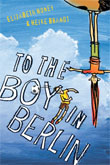|


To the Boy in Berlin
by Elizabeth Honey and Heike Brandt
Published by Allen & Unwin
288 pages, 2007


|
The Secret of Cauldron Bay
Reviewed by Sue Bursztynski
Well-known Australian writer Elizabeth Honey here collaborates with her German translator to produce a very readable novel. To the Boy in Berlin is told entirely in e-mail and postcards, which proves to be an easily read format for reluctant readers, because you can put it down after each section.
A 13-year-old Australian girl named Henni spends a holiday in Cauldron Bay, a coastal town in Victoria, where she finds books and papers belonging to the Schmidts, a German family who lived there in 1914. Henni becomes fascinated with them, especially Leopold Schmidt, the son of the family, who was her own age at the time. Leaving a note for whoever comes next, she is pleasantly surprised to receive e-mail from Berlin, from a modern-day Leopold Schmidt. He’s no relation to the original, but he’s happy to become a penpal and to help her out in her research when she decides to do a school project on the 1914 Schmidt family, and what happened to them.
Leo himself has some drama on his end when his German-born friend, Felix, is to be deported to an African country he has never seen and his mother is sent to a detention center till the authorities can find Felix, whom Leo is hiding in his uncle’s flat. There are, of course, parallels we’re meant to draw between this and what happened to the early Schmidt family when Australia went to war with their country -- and, further, what is happening to refugees in Australian detention centres today.
However, most of the story is an enjoyable investigative adventure, as Henni puts together clues with help from Leo, and even from Felix, once his problem is sorted out. What Henni and her new friends discover has an effect on the present, as she returns to Cauldron Bay and finds out things that some locals would rather weren’t found at all.
To The Boy in Berlin is entertaining and well-written and I’m sure children will enjoy it, but I am puzzled by a few things. I’d be thrilled to have a student as interested in research as Henni, but while Henni is regularly sending e-mail to her friend, it never occurs to her to look things up on the Internet. I have seen students her age look online for information about Egypt, despite the 139,000,000 hits this search term gets on Google and the perfectly good books on the shelves. Of course, in many cases it’s because they want to copy and paste for school assignments and Henni is a good student who wouldn’t do that
Still, there were a number of occasions when the heroine was ploughing through old books, or asking Leo to do it, when even I would have gone online. Lists of ships that left Germany and arrived in Australia in a particular year, and their passengers, for example. This sort of stuff has been online for ages, and if you need more detail you can send an e-mail to the authority concerned. So why is she doing it the old-fashioned way? At one point in the story, Felix does suggest she look up something on the Internet and she finds it, but not until she and Leo have wasted a lot of time asking people if they know about it and looking in old books.
I suppose it would spoil the story-line if Henni found out everything she needed to know in a few pages, but still, this needs to be thought out, because kids will certainly comment on it.
Still, it’s kind of nice to read a story that celebrates historical research and that is so easy for reluctant readers to get through. This should be enjoyed by children from about 12 to 14 years of age. | January 2008
Sue Bursztynski is the author of several children's books, including the CBC Notable Book Potions To Pulsars: Women Doing Science and Your Cat Could Be A Spy. Her fiction has been published in various SF magazines. She publishes two blogs, a general one at http://greatraven.blogspot.com and a review/SF blog at http://suebursztynski.blogspot.com. She lives in Australia.
|

